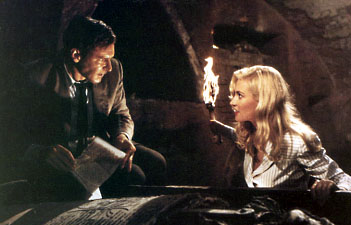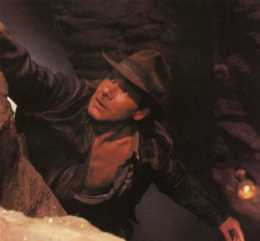On this page I will illustrate various techniques of excavation by using the most widely and famously known "archaeologist" as an example:

Click this link to see more pictures of Indiana Jones. While he is just a ficticious character, Indiana Jones represents the spirit that lives inside all good archaeologists. Indy himself is not actually an archaeologist, but an antiquarian!
It is said that excavations are the funnest part of archaeology; unfortunately, they are also very difficult and only consist of about 20-25% of an archaeologist's actual work. However, excavations are frequently shown in movies and on t.v. creating the myth that all archaeologists do are excavations, when it simply isn't true.

Indiana Jones on one of his famous excavations. This is one of the glamous, but ficticious representations of an actual excavation.
Probably the biggest and first question that pops to mind is:
"Where do you know to start digging?"
Archaeologist Mark Lehner (one of my heroes), gave an excellent explaination for where to start digging, specifically in Egypt, near Giza, which is where he works. "What there is to look for is the soft tissue of ancient society for which these stone monuments are simply the petrified remains of the preparations they made for the journey into the afterlife. The soft tissue would be the housing, the infrastructure, the socio-economic forces. And what led us to look where we're looking was to some extent the layout of the whole plateau and the patterns that we see across the landscape." For those of you who do not understand this quote, let me explain in easier terms. Basically, archaeologists look for any trace of life at all, whether it be monuments, aerial lines (look here for some cool shots of the Nazca lines), pottery, bones, traces of houses, or simply an archaeologists hunch about a certain location.
"What is the order of excavation?"
1. Find a good spot (using various techniques)
2. Permission MUST be obtained before a dig starts!
3. Survey

Indiana Jones using survey equiptment to find the right site to look for artifacts.
These are actually very, very important for all aspects of archaeology. Surveying helps map and determines the best locations to dig. There are also "off-site" surveys which are becoming more and more popular because no excavation takes place, and excavations are not only costly and time consuming, but are also destructive.
Also, another massive type of surveying is known as "offsetting." Offsetting is quick and easy and it measures, in detail, geographical features and excavated areas.
Not to mention, geophysical surveys, which are usually done by radar, and help map in 3-D, what the landscape is like below the surface of the ground that we walk on. New types using neuron scattering or gamma rays have been tested out on site, but the results haven't been to archaeologist's satisfaction. Echo-sounding is used frequently. And of course there is "dowsing" whish involves holding hazel or another twig above the ground where it will supposedly twitch over the presence of underground water or buried objects, but this system is rarely used and very debatable.
4. Map/ Site plan

Planning is just what Indy is doing right here, while he surveys the area with a bird's eye view.
5. Dig a Hole
Horitzontal- Digging a horizontal hole exposes the site at one particular time. Most commonly, "open layer excavations" are used for the horizontal approach. These are used when archaeologists want to look at a specific time period. Open layer excavations involve uncovering a site layer by layer and it is used most frequently today.
Vertical- Vertical is good for examining time periods. In it's simplest form, imagine a peanut butter and jelly sandwich. The first layer is the top slice of bread, that was the last thing you put on, so it is the most recent layer. Underneath it is the jelly.. that would be the next time period, since it isn't the most recent. Then comes the peanut butter, it was put on the bottom slice of bread which is the oldest layer.. hopefully not to the point of mold, but you get the idea. Also, the grid system was a very popular method of excavating, especially when chronology was one of the primary interests of archaeologists. Grid excavation involves square areas that are dug out from the site leaving the skeleton frame behind. The framing pieces left are called "baulks."
Neither method could be said to be the best unless all the circumstances are looked at first. Sometimes there can also be a compromise on the method used.
6. Recording Information:
Details are extremely important in recording information and data. Plans, sections, and photographs help to record information as well. Plans are basically looking at a site horizontally to scope out what is on the site. Sections are more of a vertical view of a particular part of a site and record layers and sediments. Photographs are important for keeping track of how the artifact was found, what condition it's in, and what it may have been found with.

Here is Indy teaching that lovely woman the importance of recording the information as you find it.
7. Sieving On-Site:

What if there are small artifacts in that dirt that Indy is sliding in? Are they going to be easy to see? Nope!
Even the smallest artifacts can be important and are looked for and recorded. The small artifacts are found by "sieving." Sieving is using some type of thin wire to drain the sand and pebbles from the dirt that is dug up to look for smaller artifacts. This is a job that even volunteers can do with the excess dirt. Also, being near water sources is very helpful during sieving. Basically, you dip the sieve and slightly immerse it in water and all the soil is washed away making the smaller artifacts more visible because it has been cleaned.
8. Conservation in the Field:

This site has obviously been fully restored and all the sacrificing tables and posts are back up just as they were when this site was once active... of course it isn't active now...
When possible, it is best to carefully pack artifacts and send them to a lab where they can be better preserved without risk of dirt or other outside problems. Unfortunately, many artifacts, especially those exposed to the element, need to be at least partially preserved on-site. At some point, whatever the element causing decay, the artifact reaches a point where it stops decaying and sits happily in place; therefore, it is important to store the artifacts in a similar environment. Artifacts found in water should be stored in water or damp tissue paper, and artifacts found in dry, deserty environment should be stored in a dry container. Before an extremely fragile artifact is removed from the ground, it is important to take a photograph of it first. That way if further damage is done, then there is a record of the artifact in the condition it was found. Also, there is on-the-spot treatment. Stable artifacts can be cleaned on-site. However, if microscopic traces may possibly be found on an artifact, then it should not be cleaned. Basically, the main thing to keep in mind, is that treatments should be applied ONLY when necessary. Also, it is important to make sure that is can be reversible, and that nothing is done to an artifact that is going to be biologically examined or dated. Lastly, all artifacts must be clearly labeled and in a manner that will not damage the artifact.
9. Restoring the Site:
It is a rule that archaeologists must put the site they were excavating back to it's original state before leaving. Sometimes, and only where monuments and buildings are concerned, the site may be preserved and opened to the public. In this case, the remaining artifacts must be well conserved to protect from the elements and prevent collapsing. When preserving or reconstructing, the site must be made to look as it once looked back when it was first built.

Yes, it is very difficult to leave the site that has become a second home for most of the workers, but it has to happen sometime.
Note: The information on here about excavation is VERY general. If you are interested in more of the specifics of archaeology and what is done, then check out this really cool book called The Practical Archaeologist: The Second Edition, by Jane McIntosh. It can be found at any good bookstore like Borders, Book Star, or Barnes and Noble and if you need to see the cover to look for the book, then look here. Or, if you are more computer-inclined, check out Amazon. And if you are really lazy, then I looked up the actual page for you! Just look here.
Click here to go back to the Home Page!